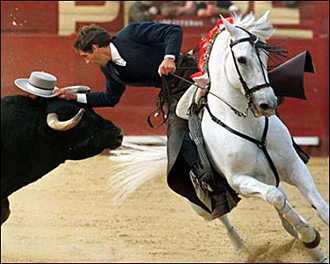 |
 |
 |
 Editorials | November 2007 Editorials | November 2007  
Will Cloning Change Bullfighting?
 Allan Wall - PVNN Allan Wall - PVNN


| | (Motrif Digital) |
The bullfight, known in Spanish as the corrida de toros, the fiesta brava, or tauromaquia, is a famous facet of Mexican culture.

The corrida de toros is a ritualized spectacle, a dramatic struggle between man and beast, style and fury, intelligence and strength.

Ernest Hemingway, an aficionado of the corrida who actually practiced it in Spain, wrote that "Bullfighting is the only art in which the artist is in danger of death..."

Bullfighting is full of traditions, from the way its participants dress, to the order of the show, to the live music which accompanies it. Bullfighting has its own specialized vocabulary, some of it incomprehensible even to Spanish-speaking outsiders.

A good matador must do more than just kill a bull. Dispatching the bull is only part of it. It's the way that he does it. The matador must display grace, courage, confidence and control, and must pace himself. If the matador fails to display these characteristics, to go too fast or too show, the audience will become displeased.

The audience too is part of the spectacle, and can be quite demanding. If the matador does not live up to their expectations, some aficionados shout unflattering (and sometimes clever) epithets. (The term aficionado has entered English, but what it really meant in Spanish was a bullfighting fan.)

I've been to a bullfight from time to time, and there's no other spectacle quite like it.

Bullfighting is also practiced in some other Spanish-speaking countries and in Spain, where it originated. Some famous matadors cross the Atlantic and fight in both Spain and Mexico.

Now, with the announcement of the first-known cloning of a fighting bull, the corrida tradition moves into the world of contemporary genetic manipulation.

Zalamero is his name - the bull's that is. Zalamero is one of those rare creatures who survived the bullring, and is now a 17-year old indultado.

What's an indultado?
The vast majority of bulls meet their death in the ring, but every great once in a while, a bull, exceptional for his fighting spirit and bravado, is "pardoned" - granted an indulto, and allowed to live out his natural life.

In 1994, Zalamero fought in the biggest bullring in the world (capacity 52,000), the Plaza M้xico in Mexico City.

An indultado bull is used for breeding, and Zalamero has already sired around 100 calves. But Mexican rancher Jose Fernandez, Zalamero's owner, has decided to take this one step further - and clone the bull. "We believe this animal deserves to keep reproducing himself," said Fernandez.

The cloning is being carried out by ViaGen, a Texas livestock cloning company. Jose Cordoba, ViaGen director in Mexico, went to the ranch near Puebla, Mexico, and extracted ear and hoof samples from Zalamero. The actual cloning is being done in laboratories in Canada. If all goes according to plan, the clone calves are to be brought to Mexico in a year and a half.

You might call them NAFTA clones - taken from a Mexican bull and cloned in Canada under the auspices of a U.S. company.

Actually, cattle breeders have been using some form of genetic manipulation for thousands of years, using selective breeding to enhance desirable traits (especially to increase milk and meat production.)

The bulls of the fiesta brava belong to a particular breed, descended from the wild cattle of ancient Spain. In Roman times these cattle were captured for use in the Colosseum.

In the same way that Holsteins (the black and white dairy cows) are bred to give much milk, so ganado bravo the fighting cattle breed, are bred to be aggressive. Interestingly, a bull is said to inherit the aggressiveness from his mother, and nobility from his sire.

The value of effective breeding bulls has long been recognized, and the later introduction of artificial insemination made it posible for such bulls to have even more offspring. Cloning takes cattle breeding to another level, but is still in its infancy.

If cloning were to become widespread, how would that affect the bullfighting business? Will new rules have to be drafted so an old tradition can catch up with biotechnology?

At this point, all I can safely do is quote Hemingway, who wrote that an artistically good bullfight requires "good bullfighters and good bulls; artistic bullfighters and poor bulls do not make interesting fights..."

Whatever biotechnology brings to the bullfight, the fiesta brava definitely requires good bulls in the bullring.
 Allan Wall is an American citizen who has been teaching English in Mexico since 1991, and writing articles about various aspects of Mexico and Mexican society for the past decade. Some of these articles are about Mexico's political scene, history and culture, tourism, and Mexican emigration as viewed from south of the border, which you can read on his website at AllanWall.net. Allan Wall is an American citizen who has been teaching English in Mexico since 1991, and writing articles about various aspects of Mexico and Mexican society for the past decade. Some of these articles are about Mexico's political scene, history and culture, tourism, and Mexican emigration as viewed from south of the border, which you can read on his website at AllanWall.net.

Click HERE for more articles by Allan Wall. | 
 | |
 |



